Juneteenth: Reflecting on Some of the Progress and Challenges for Black Americans During the Pandemic
“On Juneteenth, we recommit ourselves to the work of equity, equality, and justice. And, we celebrate the centuries of struggle, courage, and hope that have brought us to this time of progress and possibility.” – President Joe Biden, Juneteenth Day of Observance Proclamation
This year marks the first anniversary of Juneteenth as a Federal holiday. While the day has been celebrated by many for over 150 years, last year President Biden recognized June 19th should be a Federal holiday—not only to remember the inhumanity and cruelty of slavery, but also to celebrate America’s capacity for healing and hope.
As the country recovers from the economic downturn caused by COVID-19, it is a good moment to reflect on some of the progress and challenges posed by the last two years for Black Americans. Thanks to a strong vaccine rollout as well as other policies to protect workers during the worst of the COVID-19 pandemic, Black Americans have had relatively strong recovery in the labor market from the pandemic-induced recession compared to the overall population. In education, the opposite is true, with Black children and young adults bearing the brunt of the pandemic’s toll on early childhood, K-12, and postsecondary education.
This issue brief begins with a description of efforts to boost vaccination and reduce death and disease caused by the pandemic. It then analyzes both the labor market and education outcomes, using these to assess how Black Americans were faring in the spring of 2020 and where they are today. It notes policies put in place by the Biden-Harris Administration that have helped improve people’s lives, but also areas in which work must continue to ensure progress.
The Pandemic
In the early days of the pandemic, Black Americans suffered from higher COVID case and death rates than the overall population. To assess whether Black Americans continued to be disproportionately affected by COVID, it is important to adjust the rates by age as the Black population is younger on average than the population as a whole and COVID case rates and outcomes differ by age; therefore, Figure 1 shows the trends in weekly age-adjusted cases and deaths per 100,000 for the Black non-Hispanic population as a share of the rate for the overall population.[1],[2] When the ratio is greater than one, the rate for Black persons is greater than that for the population as a whole; the reverse is true when the ratio is less than one.
In early April 2020, age-adjusted COVID case rates for Black Americans were almost double the rates in the overall population. However, by September 2020 weekly case rates for Black Americans had fallen below those of the population as a whole and the ratio has remained below April 2020 highs since. Just prior to the Omicron wave, the COVID case rate for Black Americans (65 to 108 cases per 100,000[3]) was 30–40 percent lower than the overall case rate. It then peaked around 25 percent above the overall rate during the Omicron wave, before falling below the overall case rate once again. However, the more recent case rate data are generally thought to be getting less informative as people become more reliant on home tests and may not be reporting the outcomes to public health agencies.

The death rate is perhaps a more reliable indicator of the impact of COVID. Generally speaking, the death rate for the Black population relative to the overall population rises and falls with the relative case rates. And, Black persons are more likely to die of COVID than the general population (as the orange line has typically been above one throughout the pandemic). However, the relative trend in death rates has improved over the course of the pandemic. As shown in Figure 1, higher COVID case rates early in the pandemic translated into substantially higher relative death rates for Black individuals. For the week ending in March 28, 2020, the age-adjusted COVID death rate in the Black population was 2.8 times as high as the age-adjusted death rate for the overall population in the same week. By the end of October 2020, however, the COVID death rate for the Black population equaled that of the overall population. Relative death rates for the Black population peaked again around double the overall death rate in early May 2021, just after vaccines became widely available. Since May 2022, however, the Black death rate has been below the overall population death rate.
While the reasons for the changes in the relative impact of COVID on the Black community are many, the intentional dissemination of vaccines facilitated by the American Rescue Plan and implemented by the Biden-Harris Administration likely factors prominently. Vaccines have been shown to be highly effective in preventing serious illness and death from COVID infections.
In order to ensure that all Americans had access to vaccines, the Administration focused on public health strategies known to be highly effective: an all-of-society effort that included local doctors, nurses, and pharmacists building vaccine confidence in their communities; churches, civic organizations, and schools serving as ambassadors for immunization as well as spaces for vaccinations; and employers taking a stand to ensure that their employees are fully protected. Specifically, it pursued three strategies to ensure broad and equitable access to vaccines.
- Community vaccination centers were established, with the locations of major centers based on socioeconomic disadvantage in the community; some sites were paired with mobile units to meet people where they lived. Over 58 percent of doses were administered to communities of color.
- Under the Federal Retail Pharmacy Program, over 210 million doses were administered across roughly 41,000 retail pharmacies, with 40 percent of doses administered in communities with high social vulnerability index scores.
- Existing Community Health Centers (CHCs), which serve 30 million low-income and underserved patients each year and are often located in the heart of many communities of color, were made vaccine distribution sites. Vaccines were directly allocated to over 875 CHCs, with about 75 percent of doses being administered to communities of color.
Local communities also put Federal funds to use to pursue additional strategies to reach underserved populations. For example, the city of Boston provided mobile vaccinations, developed community vaccine ambassadors, and created vaccine incentive programs. While initial vaccine coverage for Black adults lagged coverage for adults overall, vaccine coverage for Black adults reached parity with the population by November 2021 (Figure 2). As of May 2022, 87.6 percent of Black non-Hispanic adults had received at least one dose of a COVID-19 vaccine compared to 86.1 percent of the overall adult population.

The effort to vaccinate not only kept many alive, but also thriving. As demonstrated in the next section, the labor market has rebounded since the end of the pandemic-induced recession, with gains for Black Americans particularly notable. Gains were sustained in part due to keeping people healthy so they could return to work and keep the economy going.
Labor Market
Following the onset of the COVID-19 pandemic, U.S. businesses closed, schools shut their doors, and those who could transition to remote work did. Between February 2020 and April 2020, payroll employment declined by more than 20 million jobs and the overall unemployment rate soared from 3.5 percent to 14.7 percent.
To understand the labor market recovery from this recession compared to prior recessions, this analysis relies on business cycle dating from the National Bureau of Economic Research (NBER) Business Cycle Dating Committee (the group that “officially” dates the beginning and end of recessions). The NBER committee defines a recession as the period between a “peak” of economic activity and the following “trough” or lowest point of economic activity.[4] “Recoveries” are dated starting from the trough. As such, March 1991, November 2001, and June 2009 are the start dates for the prior three recoveries. February 2020 has been identified as the most recent business cycle peak and April 2020 as the most recent business cycle trough. This peak-to-trough period is the COVID-19 recession from which the current economy is recovering. [5]
There are a number of labor market statistics useful for understanding economic outcomes for workers. Highlighted below are four: unemployment, labor force participation, employment to population ratio, and self-employment. The following figures show the average of the labor market data across the prior three recoveries to provide a contrast with the current one.[6] The numbers are relative to the values at the start of the corresponding recovery such that a value greater than one for the unemployment rate indicates a worse outcome relative to the start of the recovery and a value less than one indicates improvement. For labor force participation, employment-population, and self-employment, values greater than one indicate an improvement relative to the start of the recovery while a value of less than one indicates worsening labor market conditions.

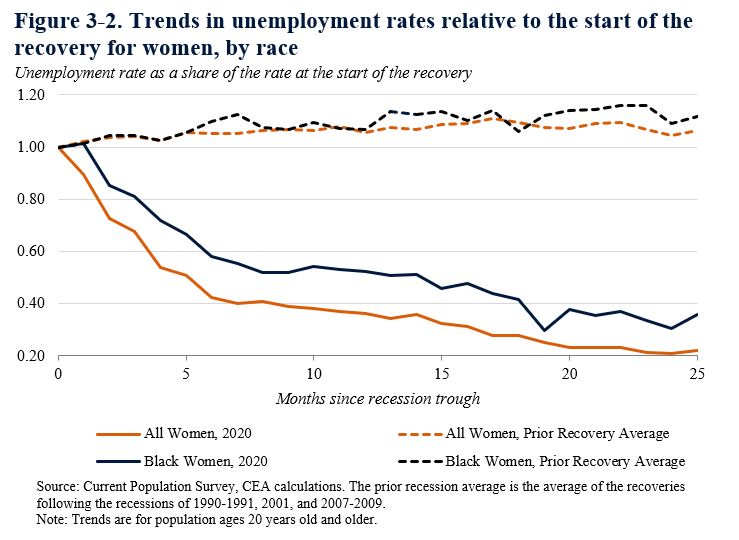
Unemployment
The solid lines in Figures 3-1 and 3-2 show unemployment rates for men and women relative to their levels at the beginning of the recovery, both overall and separately for Black men and Black women. As noted above, rates below one on the Y-axis imply improvement relative to the start of the recovery. The current recovery trends are shown with solid lines; the corresponding prior recovery averages are shown with dashed lines.
Note that during the prior recoveries, often called “jobless” recoveries, unemployment rates remained, on average, at or above recession trough levels two years in, meaning that there had on average been little to no improvement. (The values lie at or above one for 25 months after the business cycle trough). In contrast, a remarkable feature of the current recovery is the speed at which unemployment rates for all workers have fallen to near pre-recession levels compared with the prior recoveries. For Black men and women, the recovery has been somewhat slower. That said, it is notable that the unemployment rate for Black men lies below its pre-pandemic level in February 2020.
Labor Force Participation
The labor force participation rate (LFPR) is also an important labor market statistic—particularly for putting changes in unemployment rates into context. Unemployment rates reflect the unemployed as a share of the corresponding labor force (those with jobs plus those without jobs who are actively looking for work), while labor force participation rates reflect the labor force as a share of the relevant population. Unemployment rates can fall because more people are employed but also because fewer people are actively looking for work. Thus, while the unemployment rate is a “headline” measure of labor market strength, analysts consider changes in unemployment in the context of what else is happening in the labor market. This is where the LFPR is particularly useful.
The labor force participation rate for Black men has increased 8.8 percent since the start of the current recovery compared with a 2.5 percent increase for men overall (Figure 4-1). Labor force participation has also risen by more for Black women (Figure 4-2) since April 2020 (5.7 percent) compared with women as a whole (3.6 percent). These faster increases in labor force participation for Black men and women help explain the slower declines in their unemployment rates. In contrast, labor force participation rates generally continued to decline two years into previous recoveries.
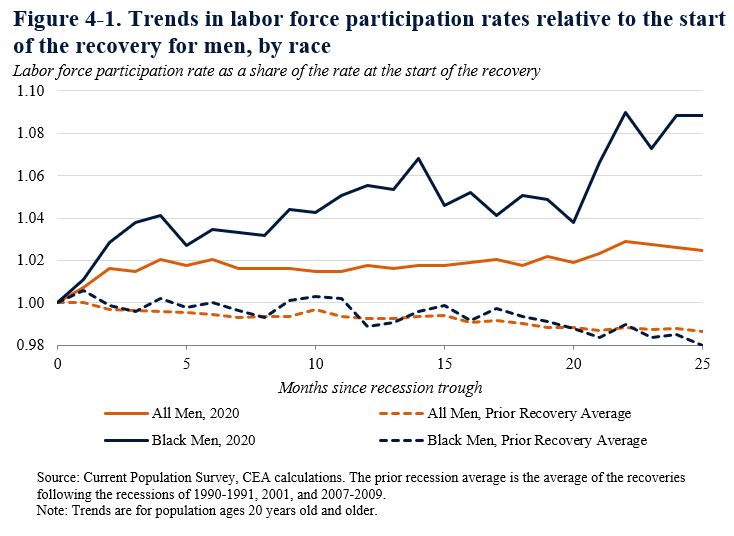
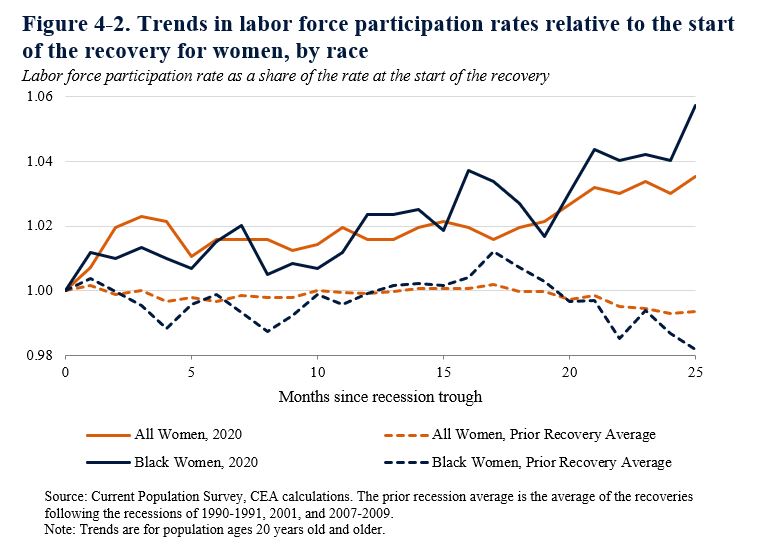
Employment-Population Ratio
Another statistic that reflects the health of the labor market is the employment-population ratio (known as EPOP). The employment-population ratio represents the share of the relevant population that is employed. Indeed, employment for Black men and women has risen somewhat faster than employment overall.
In particular, from the beginning of the recovery to May 2022, the employment-population ratio for Black men increased 22.2 percent—nearly 12 percentage points—and now stands above its pre-pandemic level (Figure 5-1). For men as a whole, the employment-population ratio increased by a smaller 13.7 percent over the same period and remains 1.4 percentage points below pre-pandemic levels. During the jobless recoveries, the EPOPs for all men and for Black men had yet to post any recovery after two years.
Black women have also experienced somewhat more employment growth than women overall during the recovery, with an increase of 19.0 percent compared with an 18.3 percent increase in the employment-population ratio for all women (Figure 5-2). However, the employment-population ratios for Black women and women overall remained roughly 1 percentage point below pre-pandemic levels as of May 2022.
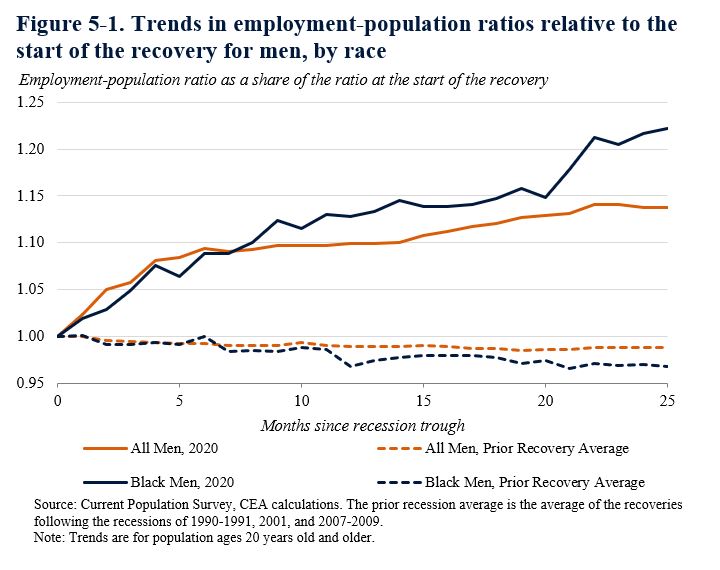
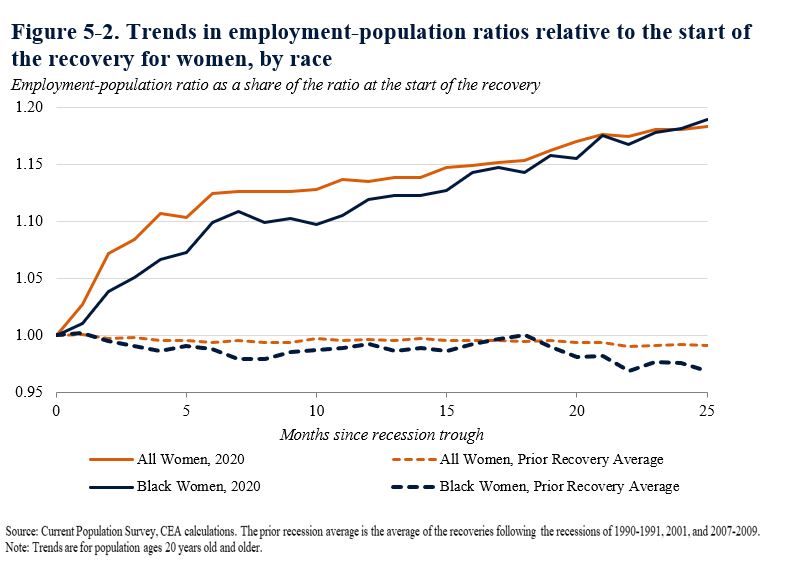
Taken together, these measures of labor market strength demonstrate real gains for workers, and in particular Black workers. Importantly, because they were able to get back to work so quickly, many workers will likely avoid the long-term ramifications of unemployment and wage loss—what economists call scarring, a particular challenge for workers of color. Moreover, the fact that the employment-population ratio is higher for Black men than pre-pandemic is significant given the overall gap in employment between Black men and other men. While these successes are notable, however, long-standing disparities remain. The Administration remains vigilant to ensure that any progress made is not undone.
Self-employment
Self-employment is a small but important subset of employment reflecting small business owners, some of whom also employ others. Small businesses were also hard hit by the pandemic recession, generating large declines in the numbers of individuals actively self-employed.
Figure 6 shows trends in self-employment for Black people and for the population as a whole for this recovery and the average of prior recoveries. As with the prior figures, the data are scaled relative to the start of the relevant recovery. The number of Black workers reporting that they were self-employed fell 22 percent in the first two months of the COVID recession compared with a somewhat more modest decline of 9 percent among all workers. Since the beginning of the recovery, however, Black self-employment rates have increased rapidly such that the number reporting to be self-employed has increased nearly 50 percent from the start of the recovery and stood 15 percent above pre-pandemic levels in May 2022.[7] In contrast, the number of individuals overall reporting self-employment rose 14 percent since the start of the recovery and was only 4 percent above pre-pandemic levels in May 2022, although still rising more than the prior recoveries.

While self-employment was recovering more quickly for Black people relative to the general population even during 2020, the gap continued to widen in the first half of 2021. This progress was likely aided by the Administration’s focus on ensuring that the 2021 round of Paycheck Protection Program (PPP) loans reached many of the smallest businesses, as well as those located in low- and moderate-income communities. Further, local communities like Tulsa, Oklahoma provided additional help by using Federal American Rescue Plan (ARP) funds to invest in supports for Black, Indigenous, and people of color small business owners.
In addition, as a way to help minority small businesses, President Biden has directed agencies to increase Federal contracting with underserved small business, setting a goal of increasing the share of Federal contracting dollars to small, disadvantaged businesses by 50 percent by 2025. Such an increase in Federal procurement spending could help provide many more opportunities for Black-owned small businesses given that the U.S. Federal government spends more than $650 billion per year on purchasing goods and services, making it the largest purchaser of goods and services in the world.
Education
While the data on labor market outcomes reflect progress for Black workers, education has gone in the opposite direction. This is of great concern, since tomorrow’s workers are today’s students.
The shift to remote and hybrid instruction during the pandemic led to lower average achievement gains for all school-age children relative to prior academic years. But the negative impact on Black students was greater, widening long-standing achievement gaps between Black students and their peers. For example, one group of researchers (Goldhaber et al. 2022) estimates that Black students’ average achievement growth in math from fall 2019 to fall 2021 was roughly one-third of a standard deviation—the equivalent of about 15 weeks of instruction—below growth expectations based on pre-pandemic fall 2017 to fall 2019 (Figure 7).[8] In comparison, the difference for white students during the pandemic period was a smaller, one-fifth of a standard deviation below pre-pandemic growth expectations or about 10 weeks of instruction.
Similarly, other researchers (Jack et al. 2022) find that pass rates on standardized tests in districts that were fully remote were 13 percentage points lower in mathematics and 8 percentage points lower in English Language Arts than those fully in-person, and that the value of in-person learning was larger for districts with larger populations of Black students. Goldhaber et al. (2022) similarly conclude that the shift in instructional mode to hybrid and especially remote instruction was a primary driver of widening achievement gaps by race and ethnicity.

Recognizing the need for targeted investments to help students recover from the pandemic-related achievement losses, the ARP included $122 billion for Elementary and Secondary School Emergency Relief (ESSER) Funds. One of the primary goals of ESSER is to provide funds to address pandemic learning loss and to invest particularly in districts and schools with students from underserved communities.
School districts are using ARP ESSER dollars for a range of policies and programs that address learning loss. For example, approximately one-quarter of school districts and charter schools are planning to use funds for tutoring. Research shows that tutoring programs yield consistent and substantial positive impacts on learning outcomes. Cleveland Metropolitan School District (which is approximately 64 percent Black) used ARP ESSER funds to increase summer learning participation seven-fold to 8,400 students participating in summer 2021 up from 1,000-1,200 students in previous years. The program will continue in summer 2022. Similarly, Baltimore City Public Schools, which serve a 74 percent Black student body, has over $248 million of ESSER funds budgeted to address the impact of lost instructional time, including expanding its tutoring and summer programs. Data are not yet available to assess how much progress has been made in most districts although early data from Chicago suggest there is still much work to be done.
While ARP resources might mitigate some of the harms caused by the pandemic, they are not enough to address the long-standing inequities in public education between Black and white children. This is one reason why the President’s discretionary budget proposal for FY23 includes an additional $20 billion in funding for Title I schools.
The pandemic also affected higher education institutions and students’ pursuit of postsecondary education and training. Figure 8 shows data on first-year college enrollment from the National Student Clearinghouse. These data estimate that spring enrollment of first-year Black students fell by 13 percent between spring 2020 and spring 2021, and fell an additional 6.5 percent between spring 2021 and spring 2022. In contrast, spring first-year enrollment for white students fell by only 3.9 percent in 2021 and increased slightly between 2021 and 2022. Notably, Black first-year students were the only reported race/ethnicity group with spring enrollment declines in 2022.
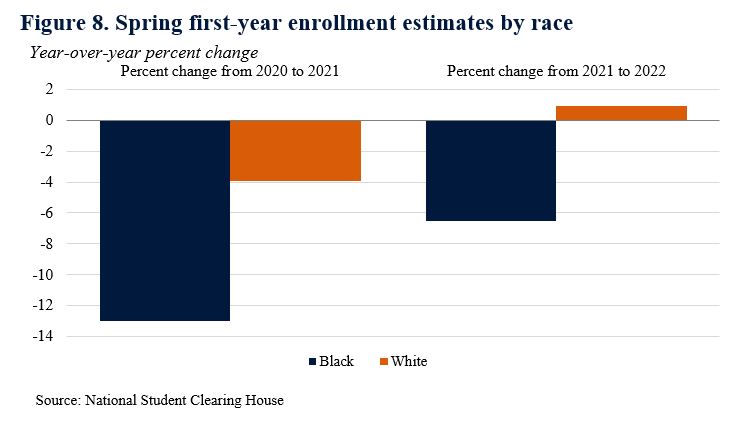
The ARP Higher Education Emergency Relief Fund (HEERF) prioritized funding to institutions and students with the greatest need by distributing funds in part based on Pell Grant receipt, as well as by providing dedicated funding to HBCUs, Minority-Serving Institutions, and other under-resourced institutions. As a result, HEERF provided more than $10 billion to community colleges and their students, more than $2.7 billion to HBCUs and their students, and $1 billion to Predominately Black Institutions and their students to help keep college students enrolled and on track toward program completion. Help for students includes providing emergency grants, discharging student debt or unpaid balances, and eliminating the practice of withholding transcripts for unpaid balances. And yet, first-year enrollment by Black students continued to decline. Some factors that may have contributed to the enrollment decline include the strong labor market and heightened health concerns for Black communities related to COVID. In addition, COVID disruptions for high schools during the 2020-21 school year likely had a negative effect on students’ college planning activities for enrolling in 2021-22, particularly for students who may rely heavily on school counselors for help in the process.
Making Pell Grants more generous is another way to help more Black students access postsecondary education and reduce their need to take on student debt. The President’s FY 2023 budget proposes to double the maximum Pell Grant amount by 2029, beginning with a more than $2,000 increase in academic year 2023-24. This could provide direct benefits to many of the more than 70 percent of Black students who depend on Pell Grants to help pay for college.
The budget also includes investments in college completion, which could yield large benefits for Black students. Among students who expect to attain a degree or certificate, only 41 percent of first-time postsecondary students who are Black complete any degree or certificate within six years of first enrolling compared with 61 percent of white students and two-thirds of Asian students. The President’s budget proposal supports outreach and student services programs to improve student retention, transfers, and completion through investments in Federal TRIO programs, Gaining Early Awareness and Readiness for Undergraduate Programs (GEAR UP), and new Retention and Completion grants.
Left unaddressed, these reductions in human capital investment have long-term implications for the future productivity of the workforce, economic growth, and improvements in our standard of living. Importantly they also suggest future widening in labor market outcomes and well-being between Blacks and the population as a whole. As discussed in Chapter 4 of the Economic Report of the President, the slowing growth in both educational attainment and health improvements over the past few decades has contributed to slower economic growth. Moreover, lagging human capital investment can increase inequality, further exacerbating the decades-long rise in income and wealth inequality. On a microeconomic level, researchers have found that more education also reduces adult mortality rates and incarceration rates, and raises civic engagement. Research also finds that maternal education has a positive effect on infant health. Thus, pandemic reductions in human capital investment can affect multiple generations in the future if not remedied.
Conclusion
As we recognize and honor Black Americans on Juneteenth and reflect on how the pandemic has affected Black workers and their families, we see there has been some improvement and some loss. Thanks to a targeted and robust vaccine rollout as well as policies to ensure that workers could weather the pandemic, the labor market rebounded in a remarkable way. This recovery was more equitable than past recession recoveries with the result that Black workers made gains they hadn’t before.
At the same time, Black students at all levels bore the brunt of the pandemic-induced school closures and resulting learning loss. While policies have been enacted to mitigate some of these harms, they have not taken root as quickly as those that targeted the labor market, and likely reflect entrenched inequities in our school systems.
A central goal of the Biden Administration’s economic strategy is to focus on policies that increase economic capacity to generate sustainable growth that is equitably shared. This goal is crucial to ensuring that the gains Black workers have made during this recovery continue. A key element of the strategy is to invest in people. This includes investing in our youngest children, helping caretakers to balance work and family responsibilities, reducing costs for important expenses such as prescription drugs and childcare, and investing in postsecondary education. Further, the ARP Equity Learning Agenda supports efforts to evaluate what worked and what did not in advancing equitable outcomes during this recovery. This work will build a body of evidence from which lessons can be adopted for future recovery efforts.
The Biden Administration understands the pain this country has gone through over these past years, and knows the disparate impact the pandemic has had on communities of color. It is committed to addressing these disparities; that Juneteenth is now a Federal holiday is a reminder of this commitment.
[1] See Age-Adjusted Rates – Statistics Teaching Tools – New York State Department of Health (ny.gov) for an explanation on why and how to age-adjust health data.
[2] Underlying case rate calculations were generated by CDC using line-level data on cases with race/ethnicity and age data. The completeness of case data with these demographics is estimated to be 62 percent. Underlying death rate calculations were generated by the CDC using the National Vital Statistics System data on mortality. The completeness of the mortality data with race/ethnicity and age is estimated to be 99 percent.
[3] Based on weeks ending 11/13/2021 through 12/4/2021.
[4] The period between the business cycle trough and the next peak is an expansion. Business cycle peaks and troughs are dated with some delay in order for enough data to be available to ensure that a peak is indeed a month of peak economic activity and a trough is correspondingly the lowest point of economic activity.
[5] The COVID-19 recession period is unusual in that it was especially brief. The NBER committee determined that the February 2020 to April 2020 period should be classified as a recession even though it was so brief because the contraction in economic activity was so great and so widely felt across the economy. https://www.nber.org/news/business-cycle-dating-committee-announcement-july-19-2021.
[6] For the unemployment rate, the labor force participation rate, and the employment-population ratio, this analysis uses the publicly available labor force data from BLS that correspond to men, women, Black men, or Black women ages 20 and older.
[7] The self-employment data were seasonally adjusted using the ratio of seasonally adjusted data to non-seasonally adjusted data for public reported data on the counts of self-employed workers who are unincorporated.
[8] Researchers often measure differences in outcomes in standard deviation units in order to be comparable across different outcomes such as graduation rates and test scores. In this study, one-third of a standard deviation in achievement growth translates to roughly 15 weeks of instruction.

